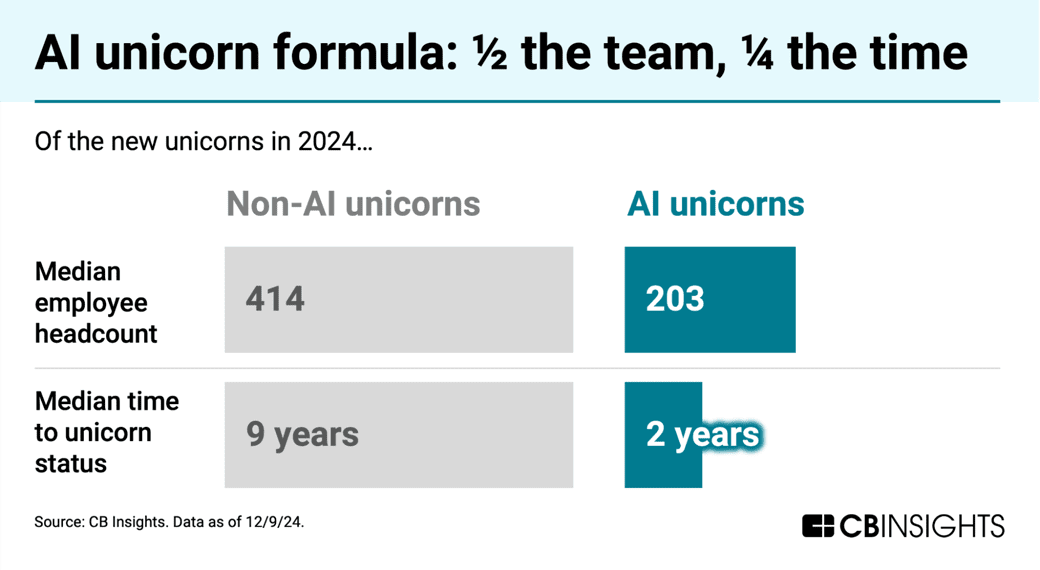AI Unicorns: Cracking the Formula with Half the Team and a Quarter of the Time
The road to unicorn status is faster and leaner than ever with the right tools and strategies
In the world of startups, achieving "unicorn" status—reaching a $1 billion valuation—is a milestone that requires grit, innovation, and exceptional execution. But in 2024, the rules of the game are shifting. AI unicorns are breaking the mould, achieving billion-dollar valuations with half the employee count and in a fraction of the time compared to their non-AI counterparts.
The Numbers Speak for Themselves
A recent report by CB Insights reveals staggering differences in the trajectory of AI startups versus traditional tech companies:
Median employee count: AI unicorns hit the billion-dollar mark with just 203 employees, compared to 414 for non-AI unicorns.
Time to unicorn status: While non-AI companies take an average of 9 years, AI unicorns accomplish this feat in just 2 years.
These figures underline a fundamental transformation driven by artificial intelligence. AI-first startups are redefining how businesses scale, leveraging cutting-edge technologies to amplify efficiency, agility, and growth.
Why Are AI Unicorns Growing Faster?
Scalability Through Automation
AI startups often build their products around automation, eliminating the need for large teams to perform repetitive or labour-intensive tasks. For example, generative AI platforms can handle customer support, content creation, and product design, reducing dependency on human resources while speeding up workflows.Exponential Data Leverage
AI thrives on data. Startups in this space can extract insights, predict trends, and optimize their operations in ways traditional companies cannot. Machine learning models are designed to improve over time, enabling companies to deliver better results with minimal additional investment.Global Market Fit from Day One
AI products, particularly SaaS solutions, are inherently scalable and can be deployed globally with minimal additional infrastructure. This allows startups to address larger markets faster than companies tied to physical goods or localized services.Investor Interest
The AI boom has caught the eye of investors, who are more willing to pump capital into promising AI ventures. This influx of funds accelerates growth, allowing startups to hire top talent and expand operations rapidly.
Why This Matters for Businesses
For executives and decision-makers, the AI unicorn phenomenon signals a broader trend that cannot be ignored:
Competitive Pressure: Businesses in every sector must adapt to the rapid pace of AI-driven innovation. Traditional companies may find themselves outpaced by leaner, faster AI competitors.
Workforce Transformation: The focus on automation and AI tools will redefine job roles and require upskilling existing teams.
New Investment Strategies: Investors and venture capitalists are already prioritizing AI-driven business models, reshaping funding priorities.
Industry Use Cases: How AI is Fueling Unicorn Growth
Retail: AI-driven startups are revolutionizing supply chain management, optimizing inventory, and personalizing customer experiences with machine learning.
Healthcare: AI unicorns are building tools for predictive diagnostics, automating administrative workflows, and enabling telemedicine at scale.
Entertainment: Companies like those leveraging generative AI for content creation are drastically reducing the time and cost needed to produce films, music, and gaming assets.
Finance: AI startups are redefining risk analysis, fraud detection, and investment strategies, allowing financial institutions to make better decisions faster.
Key Takeaway: AI as the Great Accelerator
The rise of AI unicorns highlights the transformative potential of artificial intelligence. By leveraging scalable, data-driven solutions, these companies demonstrate that innovation doesn't require bloated teams or decades to achieve monumental success. Instead, the road to unicorn status is faster and leaner than ever with the right tools and strategies.
For businesses and leaders, the message is clear: Those who embrace AI's efficiency and scalability will thrive in the new era of innovation—those who don't risk being left behind in a world that’s moving four times faster.


